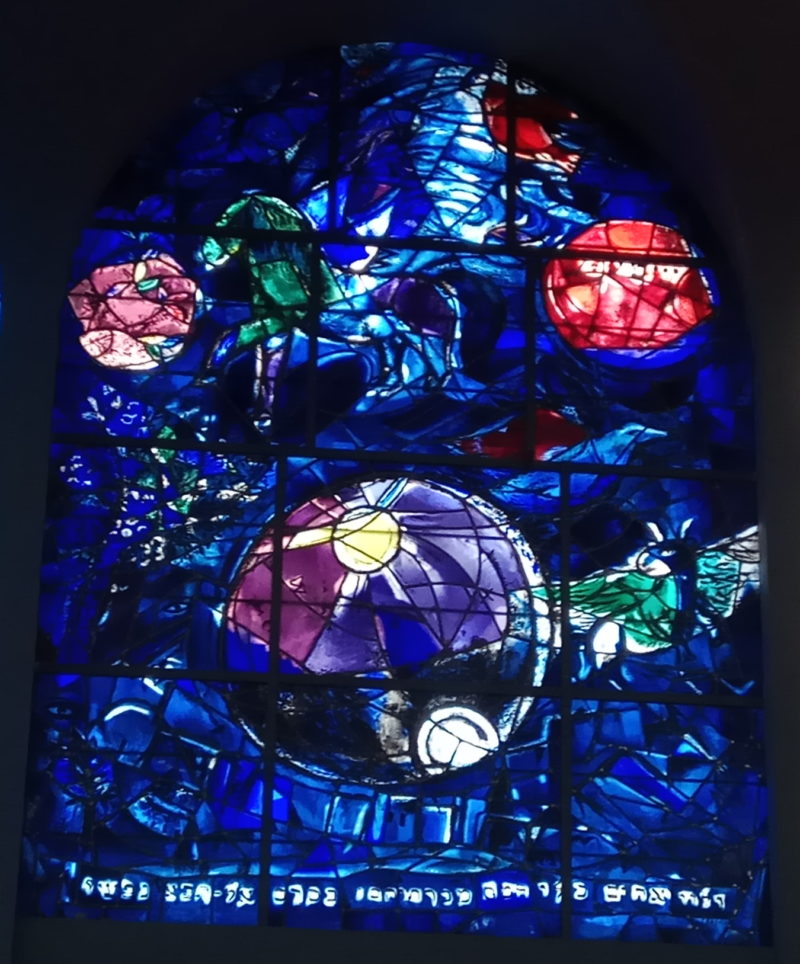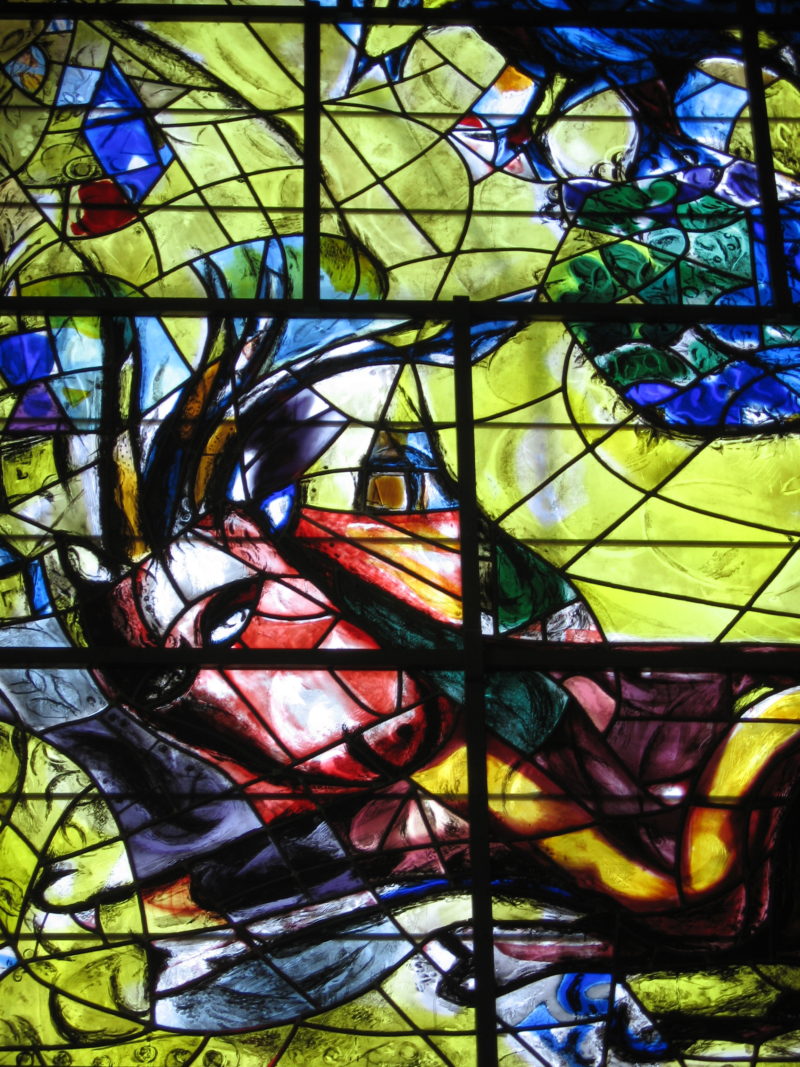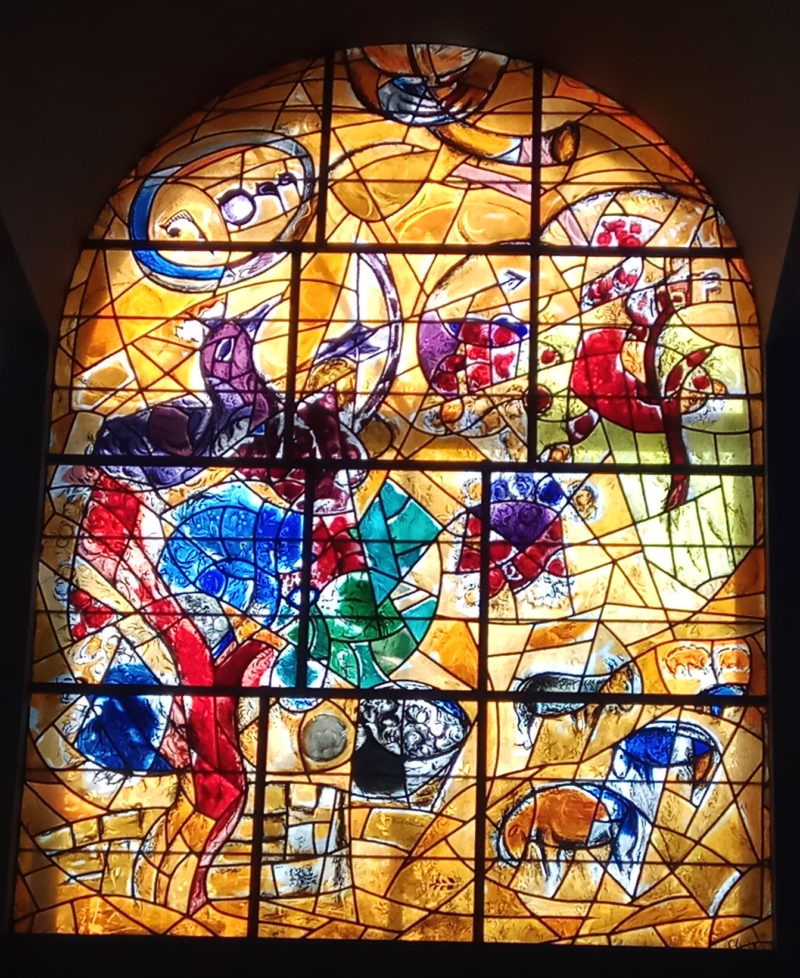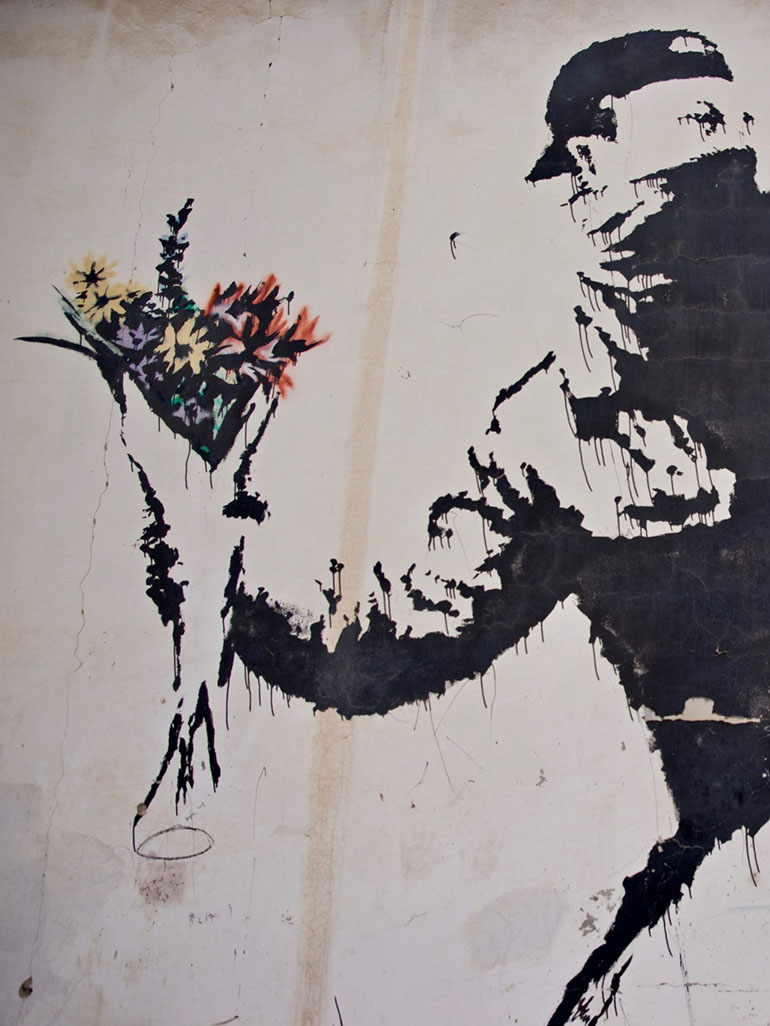
Introduction
In early 1962, renowned artist Marc Chagall stood in the synagogue at the Hadassah-Hebrew University Medical Centers in Jerusalem. Above him were twelve stained glass windows that he had designed himself. It was this where he delivered a touching speech.
Chagall had an audience of about three hundred people as he installed the windows, including the Americans and French ambassadors, delegations from Hadassah, Israel officials, and the Women’s Zionist Organization of America.
Sir Henry and Lady d’Avigdor-Goldsmid commissioned the painting and installation of the windows as a tribute to Sarah d’Avigdor-Goldsmid, their daughter, who met an untimely death aged 21 in a sailing accident off Rye. Speaking during the installation, Chagall said1:
This is my modest gift to the Jewish people who have always dreamt of biblical love, friendship, and peace among all peoples. This is my gift to the people who lived here thousands of years ago, among other Semitic people.
What do the stained glass windows stand for?
The twelve stained glass windows depict what might be considered a set of heraldic symbols for each of the first Twelve Tribes of Israel.
An ancient Cabbalistic belief asserts that the prayers of Israel reach the gates of heaven, which are twelve in number, each corresponding to one of the original Twelve Tribes of Israel, and reach God as per the original tribe of the worshiper. While due to intermarriages, the twelve tribes dissolved, it is believed that the twelve gates still exist today.
Chagall’s stained glass window represents these twelve gates through which prayers of individuals who worship in the Hadassah synagogue in Jerusalem will have direct access to heaven.


How Chagall chose him images
For these windows, Chagall decided upon emblematic depiction rather than an illustration of scriptural episodes. Yet his choice of symbols of the twelve tribes depends on just as primordial a tradition. This tradition was also tolerated even in the eras of comparatively strict construal of the rabbinical prescription on the representational artworks.
Reception
The worshipers in the Hadassah synagogue will only see the colorful windows, gorgeous and solemn. However, some art commentators believe that Chagall’s best and most priceless work is that he created in Moscow, Paris, and Berlin between 1910 and 1930. They will perhaps see the twelve windows as the fruit of one of Chagall’s more unadventurous periods, not quite compared to his great geniuses, which is often seen as of clownish and pastoral nature by many art critics.



Analysis
The medium of stained glass has previously suffered, in terms of aesthetic and technique, that now can justify its demands, different from those made when for instance, we contemplate the rose windows of Chartres. The general effect of a modern stained glass window is that of an inexplicably luminous mural painting created on a large scale instead of a translucently hieratic Byzantine mosaic or even a large jewel consisting of numerous stones that have been painstakingly assembled and set.
What does the Hebrew text mean?
Much of the iconographic aspect of the rose-window of Chartres is not instantly apparent to the audience when they contemplate the whole in overwhelmed delight. Still, when you look at one of the twelve Chagall’s windows, it is easy to see the emblematic figures at once, alongside the Hebrew texts, though you can fail to read or even interpret them.
The Hebrew texts and the iconographic details were suggested to the artist by scriptural passages in the Bible where Jacob (Israel) blesses his sons and the whole twelve tribes, assigning to each an emblem that has remained a sort of heraldic tool. Chagall’s treatment of these tools is more intentionally traditional than any of his works, except those of etched illustrations to the scriptures.
Video: David Rubinger about Marc Chagall
What makes this work stand out?
The stained glass method is personal to Chagall or even novel. Compared to other works created using this medium by other famous artists, Chagall’s windows are far more abundant in color and texture thanks to his unique etching and finishing of the glass. By comparison, the colorful windows of the Matisse chapel in Vence, from which Chagall lives nearby, would appear pale and technically complicated, as would Leger’s glass windows in Audin-court.


Even the meek glass windows of the Braque chapel close to Dieppe could not compare to Chagall’s windows, nor the Manessier windows in Assy, though much more in simplicity in technique and less rich in color. Otherwise, it can be said to possess the same uplifting effect.
Every pane represents Chagall’s world, both real and fantasy, or his love for the people of Jerusalem, his profound sense of identification with the history and culture of Jewish people, and his early life in the Russian shtetl.



Inspiration
All the time I was working, I felt my mother and father looking over my shoulder; and behind them were Jews, millions of other vanished Jews – of yesterday and a thousand years ago.
All the time I was working, I felt my mother and father looking over my shoulder; and behind them were Jews, millions of other vanished Jews – of yesterday and a thousand years ago.
– Chagall
In this project, the bible was his primary source of inspiration, especially the part where Jacob blesses his twelve sons and the blessings of Moses on the original twelve tribes. Each window in the synagogue contains its unique color as well as a quotation from the individual blessings.
Location
Kalman Ya’akov Man St, Jerusalem
Call for more information: +972-2-677-7109
Hours:
- Sun-Thu: 8:30-16:00 – 15:30 last entrance
- Fri-Sat: Closed
The synagogue hosts various events and ceremonies. The exhibit is not open to the public during these events.
The twelve windows
Reuben
The first Chagall’s window represents the first son of Jacob and Lea, Reuben, who disappointed his father with his behaviors and how he neglected his duties as the firstborn. The window contains two blessings from Jacob and Moses.
Jacob: Reuben, you are my firstborn. My might and the first fruit of my vigor; Exceeding in rank and exceeding in honor. Unstable as water, you shall excel no longer…
Moses’s blessing:
This window composes the mandragora leaves. The blue hue and the fish symbolize the unstable was water phrase from Jacob’s blessing. The fish on the window represents fruitfulness, while the radiant circle at the top symbolizes sunrise, which is the firstborn status of Reuben.
Simeon
The second son of Jacob and Lea, Simeon, is perhaps known for the cruel revenge they took on the Shechem after their daughter was raped by the son of the king of the city.
Jacob blessing: “Simeon and Levi, brethren; their weapons are tools of lawlessness. Let me not be included in their council. Let me not my being counted in their assembly for when wrathful they slew men. And when pleased, they maimed oxen. Cursed be their anger, so fierce, and their fury, so cruel! I will scatter them in Jacob and disperse them in Israel.”
There was no Moses’ blessing for Simeon. The animals on the windows do not face each other, which signifies tension, disquiet.

Levi
Levi is the son of Lea, and he and Simeon cruelly murdered the entire town. He received the same blessing/curse as Simeon. However, unlike Simeon, Levi was blessed by Moses.
The yellow color on this window depicts the gold user in the sanctuary. Gold was the major component in the scared outfit of the High Priest. The items on the lower part of the window are the Tablets of the Law.

Judah
The fourth son of Lea, Judah, was blessed by Jacob and Moses, and the tribe later produced prominent leaders and kings, including King David.
The red color on the window refers to the image of wine in the Jacob, and it may be associated with the Royal purple garment. The crown on top is noticeable, as many kings came from the tribe. The significance of the lion at the bottom of the window is also apparent. Behind the lion is the city of Jerusalem.
Dan
The image of a lion on this window represents kingship as the “Messiah” comes from the tribe of Judah. However, his mother comes from the tribe of Dan.
Naphtali
The symbol on this window is a hind, the most relevant symbol on the pane, and alongside the bird, it signifies freedom.


Gad
This window is greenish with many images of weapons, including spears and shields, representing the warlike nature of the tribe.
Asher
The most important symbol in this window is the olive oil. The background color of dark grey-green is simply a coloration of the olive tree.

Issachar
The image on this panel is a white tent at the center. There is also green coloration, which signifies the land of Galilee, where the tribe of Issachar was located.

Zebulon
This window also has a white color, signifying the tribal flag.
Joseph
The orange-yellow color of the window represents the ripe corn. It shows a generous yield of the son and the crop of the moon.

Benjamin
The large circle at the center of the pane depicts unity, while the animal at the bottom is a Ravening Wolf devouring its prey.

Final words
Marc Chagall is the epitome of modern Jewish art. These twelve stained glass windows enclosing the synagogue at Hadassah Medical Center in Jerusalem, Israel, can only fully be understood when viewed against his (Chagall’s) sense of identification. This includes Jewish history, its victories and tragedies, and his personal experience in the shtetl of Vitebsk, his birthplace, and where he grew up.
Chagall’s main inspiration came from the Bible, particularly the book of Genesis 49, where Israel (Jacob) blesses his sons, and the Book of Deuteronomy 33, where Moses blesses the original Twelve Tribes of Israel.
Several notable painters have tried to revive this art of stained glass composition. Still, only Chagall was successful in achieving this feat, albeit with a different quality to that of the master painters Chartres and Reims.
Explore nearby
Hadassah Hospital, Jerusalem, Israel
 Francis Alÿs's & 58 liters of paintPerformance ended (staged in 2004)8 km away
Francis Alÿs's & 58 liters of paintPerformance ended (staged in 2004)8 km away Banksy's Rage, The Flower Thrower10 km away
Banksy's Rage, The Flower Thrower10 km away Banksy's Girl with Balloon13 km away
Banksy's Girl with Balloon13 km away North Korea's oversea sculptures225 km away
North Korea's oversea sculptures225 km away











